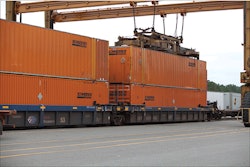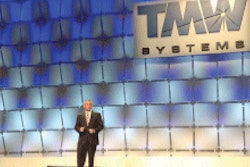Back-to-back-to-back
Truck of the Year judging lets you stare the future in the face
By Jack Roberts

The event was divided into two distinct classifications – medium- and heavy-duty. The medium-duty entries were:

• The Hino 195H: A “mild” hybrid optimized for urban pickup and delivery;
• The Isuzu Reach: A fuel-efficient P&D truck designed in tandem with Utilimaster;
• Kenworth’s Model K370 cabover: A heavy-duty P&D truck with several new “Americanized” components and features; 
• A Peterbilt Model 337 dump truck: The conventional “big boy” in the group.
Things were equally interesting on the heavy-duty side, where the judges drove:
• Freightliner’s Cascadia Evolution: The company’s super-slippery aerodynamic next-generation tractor (see CCJ Test Drive, page 24);
• Kenworth’s T680: A new tractor featuring next-generation aerodynamics and new concepts in cab, sleeper and driver comfort;

• Western Star’s 4700SF dump truck: A sleek modern look from a company known for its blend of heightened refinement and bare-knuckle-brawler toughness.

OEMs today are serious about innovation and technology.
The interesting thing to me this year, however, was the realization that every single truck entered is – in 
*Truck of the Year: The judges in Las Vegas were given some innovative choices.

* Not just a new fender: The days of “new” truck models with only minor revisions are long gone.
 Every contender entered in this year’s Truck of the Year event is – in one way or another – a major step forward.
Every contender entered in this year’s Truck of the Year event is – in one way or another – a major step forward.The days when a truck manufacturer simply could rework the fenders and grillwork and call a truck “new” are long gone. Today’s trucking industry demands innovation and revolutionary thinking – and every truck entered in the Truck of the Year program reflected those forward-thinking concepts in one way or another.
 JACK ROBERTS is Executive Editor of Commercial Carrier Journal. E-mail [email protected] or call (205) 248-1358.
JACK ROBERTS is Executive Editor of Commercial Carrier Journal. E-mail [email protected] or call (205) 248-1358.OEMs are serious about innovation and technology – good news for fleets that accept new concepts and ideas and put them to work.
Daimler remains ‘cautiously optimistic’ about 2013
DTNA revises 2012 forecasts
At a press briefing during last month’s 2012 American Trucking Associations’ Management Conference & Exhibition, Daimler Trucks North America said it had revised its overall NAFTA 2012 Class 6-8 truck sales forecast downward from 378,000 units to 332,000 units, but noted that figure still represents a 9 percent growth from 2011.
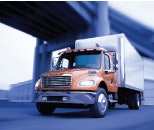 DTNA said it has overtaken rival Navistar in the U.S. Class 6-7 truck market with a 37.1 percent market share, up 2.1 percent from yearend 2011.
DTNA said it has overtaken rival Navistar in the U.S. Class 6-7 truck market with a 37.1 percent market share, up 2.1 percent from yearend 2011.Martin Daum, DTNA president and chief executive officer, said year-to-date the company had achieved a 33.4 percent market share, up 1.6 percent from 2011. “[2012] could have been a tremendous year for us, but it’s still too good to complain,” said Daum, referring to earlier forecast numbers.
“The good thing is DTNA’s growth is outpacing the market’s [growth] – our sales went up by almost a third compared to last year,” said Andreas Renschler, member of the Daimler AG Board of Management.
Renschler said the company will conduct a limited number of shutdown days at DTNA sites in October to adjust production schedules to recent market developments, including “unstable demand due to volatile freight trends in the U.S., higher diesel prices and a slower overall economy.”
Looking long-term, DTNA expects NAFTA Class 6-8 truck sales to average 375,000 units per year from 2010 through 2019, which would represent a 3.5 percent increase from the previous decade and an 8.3 percent increase from 1990 through 1999.
“The good news is the good years of the next decade are ahead of us – the question is when will they come?” said Daum. “We have a cautiously optimistic view of 2013, and then at some point, demand should pick up. We don’t know when the next peak starts – we only know that it will happen one day overnight.”
DTNA revised its earlier U.S. Class 8 truck market forecast downward from 219,000 units to 185,000 units, which still represents an 8.2 percent increase from 2011 and a 73 percent increase from the 107,000 units sold in 2010. Year to date, Daum said, DTNA has overtaken rival Navistar in the U.S. Class 6-7 truck market with a 37.1 percent market share, up 2.1 percent from yearend 2011. – Jeff Crissey
Cummins to shut down facilities, reduce work force
ISX15 earns EPA 2014 certification; midrange NG engine planned
Cummins Inc. last month announced actions to respond to the weakening global economy by cutting costs, including planned work week reductions, shutdowns at some facilities and targeted work force reductions.
 Cummins received EPA certification for its ISX15 engine, meeting both the 2013 regulations and greenhouse gas and fuel-efficiency rules that take effect in 2014.
Cummins received EPA certification for its ISX15 engine, meeting both the 2013 regulations and greenhouse gas and fuel-efficiency rules that take effect in 2014.“We continued to see weak economic data in a number of regions during the third quarter, increasing the level of uncertainty regarding the direction of the global economy,” said Tom Linebarger, chairman and chief executive officer of the Columbus, Ind.-based company. “As a result of the heightened uncertainty, end customers are delaying capital expenditures in a number of markets, lowering demand for our products.”
Linebarger said Cummins has lowered its full-year revenue forecast, with the most significant changes in its North America heavy-duty truck and international power generation markets.
The company said it expected to reduce its work force by between 1,000 and 1,500 people by the end of the year. “Responding quickly and strategically during these challenging economic times will pave the way for Cummins to emerge stronger as a company when markets inevitably rebound,’’ said Linebarger.
In other news, Cummins received certification for its ISX15 engine from the U.S. Environmental Protection Agency, meeting both the EPA 2013 regulations and the new greenhouse gas and fuel-efficiency rules that will take effect in 2014.
Also, Cummins Westport now is developing the ISB6.7 G, a midrange 6.7-liter natural gas engine expected to be in production by 2015 and designed to meet EPA and California Air Resources Board regulations in force at the time of launch.
CCJ Test Drive:
Finding 10 mpg
The 2014 Cascadia Evolution shows the way forward.
by Steve Sturgess
When Freightliner’s 2014 Cascadia Evolution becomes available early next year (ordering is open already), it will offer revisions to the tractor’s already extraordinarily good aerodynamics with a package that wins a few more decimal points in miles per gallon.
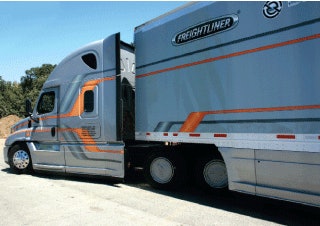 The Freightliner Cascadia used for the Evolution of Economy Tour was a 2014 model with trailer aerodynamic aids simulating available products.
The Freightliner Cascadia used for the Evolution of Economy Tour was a 2014 model with trailer aerodynamic aids simulating available products.Also, some changes to the fuel and air handling systems on the DD15 engine bring a contribution that, old model to new model, shows 7 percent fuel savings. It was hard to imagine how the Cascadia could be improved, but it has been, and since the changes impact the pocketbook, they are significant. Paired with the new Detroit DT12 smart transmission, it’s a combination that’s hard to beat.
We were let loose in the demonstration truck for these and some other new components that, bundled together, allowed a test-track fuel economy of 10.67 mpg. To prove this wasn’t just the result of tricky test procedures, the same truck was employed in an over-the-highway Evolution of Economy Tour, a run from San Diego to Gastonia, N.C. Those real-world conditions yielded 9.31 mpg with a nearly maxed-out load. This truck could push fuel economy close to the magical 10 mpg.
Aerodynamic efficiency improvements here are subtle – likely only possible because Freightliner has its own wind tunnel at its prototype shop on Swan Island, just outside Portland, Ore. Hood and bumper closings keep air flowing to the sides. A change to the air dam under the front reduces the amount of air flowing under and becoming trapped in the engine compartment or around axles and the suspension.
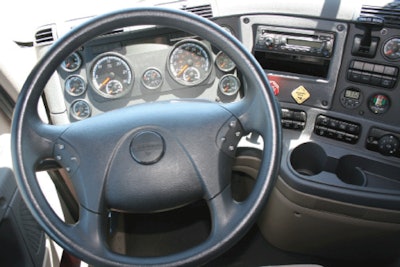 The Evolution’s dash and controls now include an instrument cluster with gauges in the speedometer and tachometer.
The Evolution’s dash and controls now include an instrument cluster with gauges in the speedometer and tachometer.A smaller radiator for less air to pass through saves some weight, yet adds some durability and reliability with a new mounting. It’s the result of the switch to selective catalytic reduction, requiring less cooling for the still-present exhaust gas recirculation in the 2010 DD engines. At the same time, the new radiator has a revised baffling system for greater efficiency.
Also new is the adoption of an asymmetric waste-gated turbocharger for the “fleet” horsepower ratings, like the 455-hp DD15 we tested. By dispensing with the turbocompounding on these lower-rated engines, there is an economy gain and a savings of about 100 pounds.
New chassis fairings and longer side extenders do their work to reduce drag. A change to the windshield seal, a sleeker elliptical shape for the mirrors and an integrated antenna further boost efficiency.
That’s the Evolution in a nutshell. But our test truck might well be called the ultimate Evolution, with 6×2 drive, ultra-low-profile wide single tires, wheel covers and a trailer with aerodynamic aids created in Freightliner’s wind tunnel but representative of commercially available products. It’s the ultimate you can spec today on top of the 2014 Evolution.
Smart transmission
We’ve driven other truly smart transmissions, but the DT12 does everything the best driver can do, and it does it quicker, smarter and, at the end of the day, more efficiently. The direct transmission is backed up by a Meritor final drive of 2.50:1 in the single drive axle to give it the tall gears it needs for the economy with the direct top gear. The tandem is the available Meritor 6×2 setup with a forward drive axle with load and anti-spin logic to reinforce the drive axle if traction is compromised.
It’s increasingly gaining attention for its 400-pound weight savings and the additional fuel economy from only one set of gears back there. Some fleets – notably Mesilla Valley Transportation – have made this a standard spec on their trucks and are enjoying the fuel savings day in and day out. It’s also a spec that’s been proven over decades in Europe, even in notorious spinout applications such as off-highway logging.
The ultra-low-profile super singles are by Michelin. It’s tough to believe they’ve been in the marketplace for 10 years, with more than a million produced – which should be enough to convince anyone they work. Paired with aerodynamic hub covers developed by Jon Fleck, not one went flat on the Evolution’s coast-to-coast run.
In the cab, there’s little new about the Evolution except in the dash and controls, which now include an instrument cluster with gauges in the speedometer and tachometer, making use of otherwise underused real estate. It puts the coolant-temperature and oil-pressure gauges where you want to see them, along with a repositioned fuel/DEF gauge. There are in-wheel switches for the engine brake, cruise control, marker light interrupter and flasher, as well as a new DT12 shifter control on the steering column.
We were fully loaded sitting in a turnout at Yountville, Calif., facing southbound through the Napa Valley on State Route 29. It was hot outside, but the 2014 Cascadia Evolution was cool and comfortable. I was accompanied by T.J. Reed, director of product marketing for Daimler Trucks North America.
With Reed’s help, I explored the features of the new transmission while negotiating Interstate 80, other divided highways and then some two-lanes through the town of Napa and back through the vineyards of the region.
Starting out, with a foot planted on the service brake, I rolled the direction selector to Drive and leaned on the air valves to release the brakes. All that remained to do was to move the right foot and squeeze down on the throttle. There’s no danger of rolling back, as a creep-and-crawl feature gives a slow forward motion without application of the foot-feed. For steeper hill starts, a hill-hold feature commanded by the transmission keeps service brakes applied until a torque sensor tells the air brakes to release – then off you go smoothly.
The clutch is a conventional dual plate with air engagement commanded by the transmission controller. Any time you’re sitting in traffic or at a light with the foot brake applied, the clutch opens. Releasing the foot brake closes the clutch and puts the transmission into crawl mode. From then on, walking on the throttle accelerates the truck according to how much pedal you give.
For medium to heavy pedal demand, the transmission responds well, choosing the right gear for the conditions – including truck weight, which for us was 76,000 pounds – and skip-shifting for the quickest or the most economical acceleration. In one sequence in “Econ” mode and moderate throttle, the transmission shifted 2, 3, 5, 7 and 8 within about 50 yards, and we were off to the races.
In the upshifts, interaction between the transmission and the engine retarder is more complex than just slowing the engine speed between shifts. Initially, the retarder aggressively reduces engine speed, but as it approaches synchronicity with gear and road speed, two cylinders start to fuel even though the other four are still in retarder mode. This keeps the turbocharger spooled up, and when the upshift completes, the engine is ready to pour on the coals in the next gear.
The advantage of this sequence is to punch the shift through as quickly as possible and also to minimize the torque break during the shift so that the truck slows less. Since there is less speed rolloff, the feature actually saves some fuel – perhaps only a tiny amount, but still a savings. From a driver’s perspective, it enhances performance – and remember, we are still in Econ mode – to get up to speed faster.
This outbound stretch of highway has regular traffic lights, and all seemed to turn red as we approached, but it was no problem pulling down a notch or two on the shift lever for the retarder; as a bonus, the system is sensitive to how much braking is demanded. In the third demand position, Maximum, an aggressive downshifting regime brings downshifts to make the retarder work at its peak efficiency, but even without this feature, as you slow for a light or a corner, the transmission downshifts to be ready for the next acceleration demand.
Another cool features is e-Coast, where the transmission goes to neutral and the rpms fall to idle when cruise detects no throttle to retain road speed. It’s remarkable how frequently this feature comes into use; on the coast-to-coast tour, e-Coast mode accounted for about 25 percent of the total mileage.




